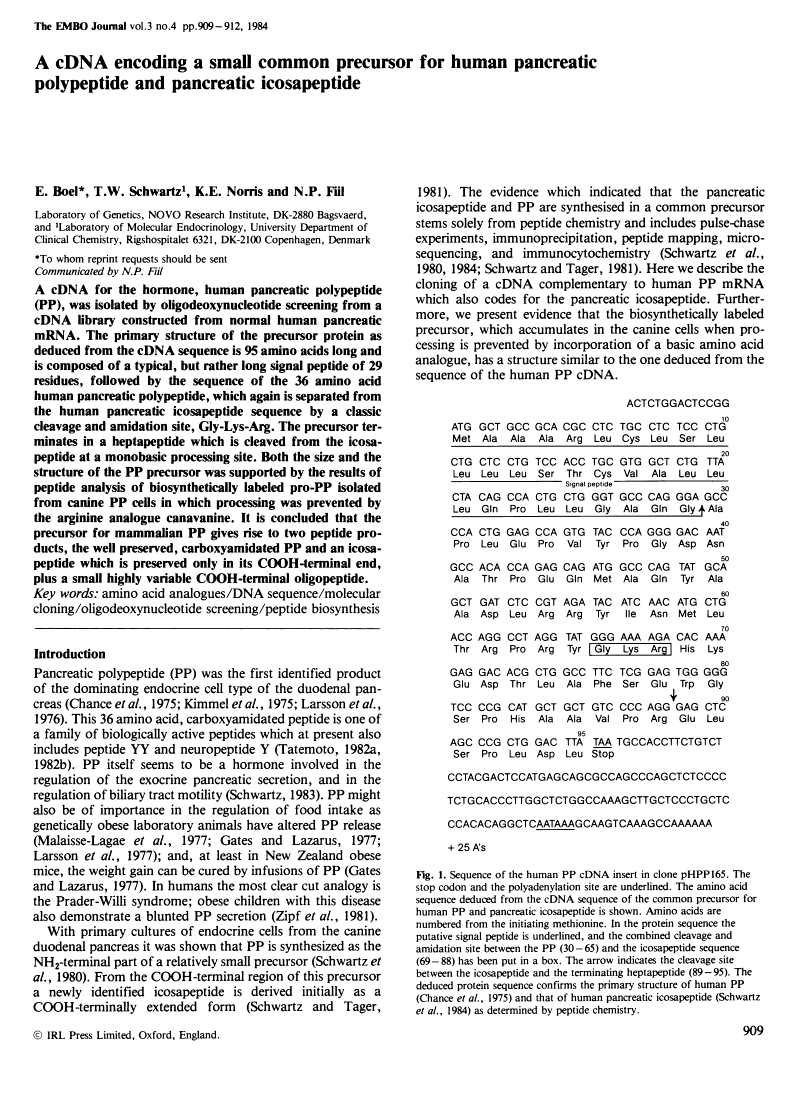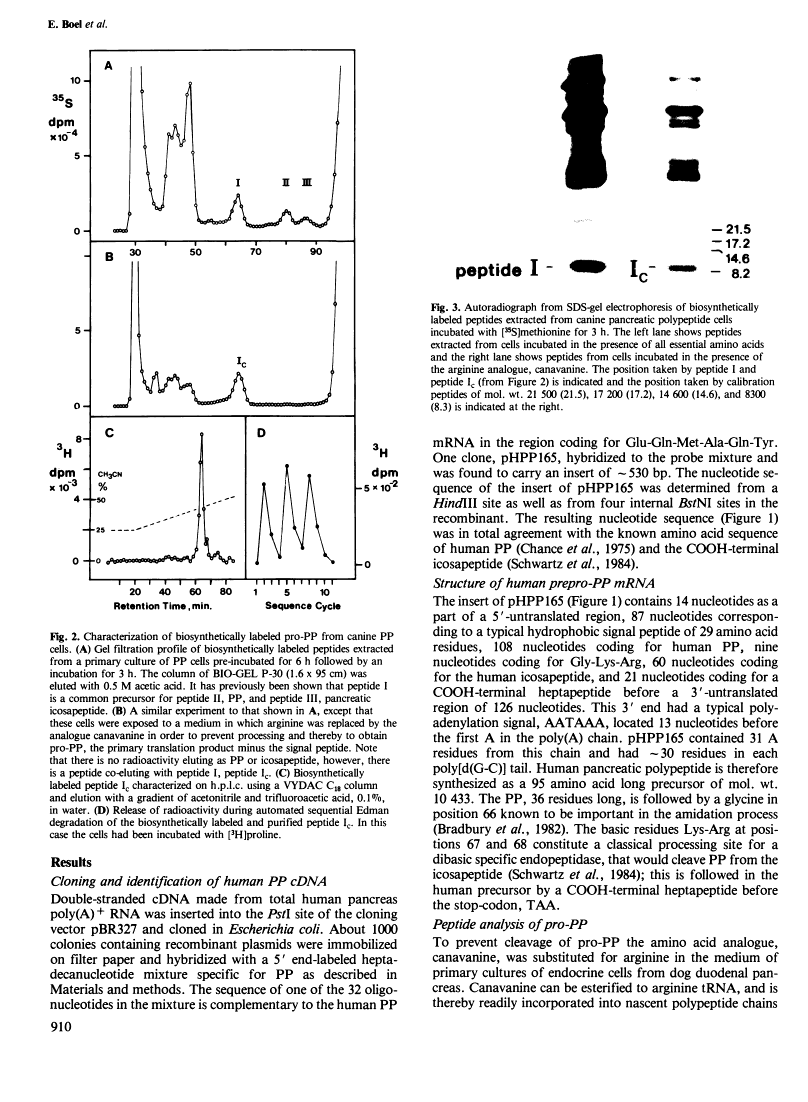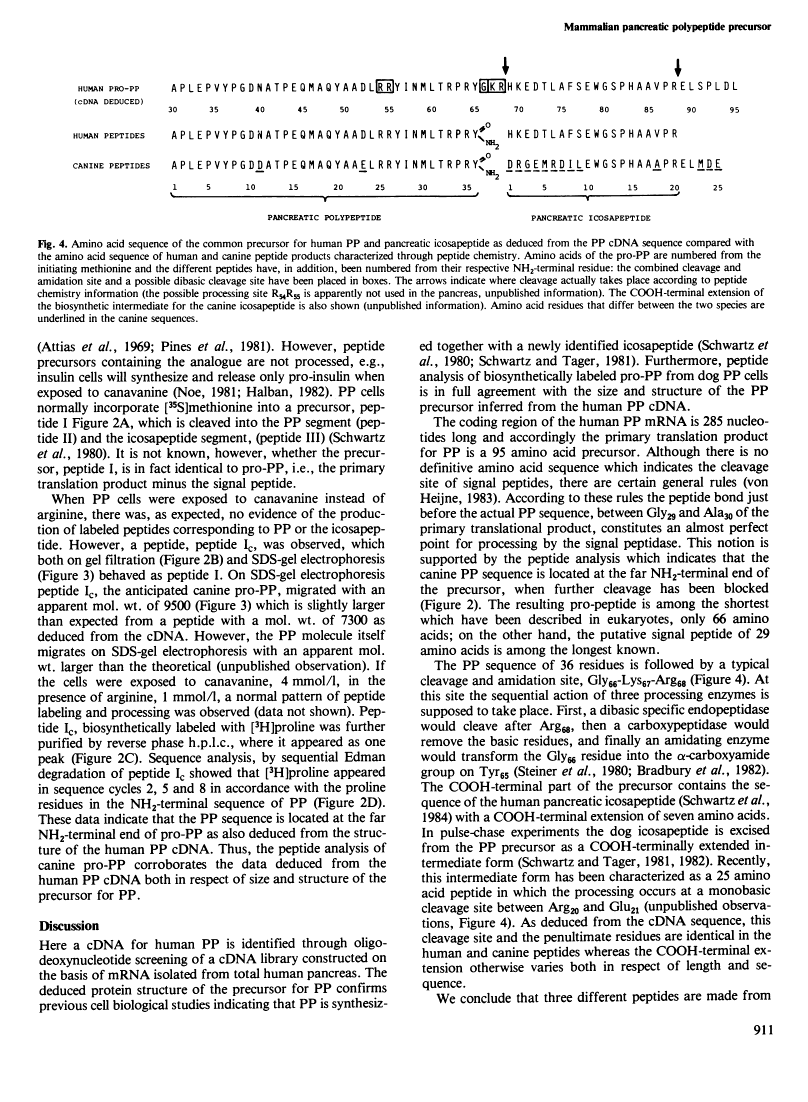Abstract
Free full text

A cDNA encoding a small common precursor for human pancreatic polypeptide and pancreatic icosapeptide.
Abstract
A cDNA for the hormone, human pancreatic polypeptide (PP), was isolated by oligodeoxynucleotide screening from a cDNA library constructed from normal human pancreatic mRNA. The primary structure of the precursor protein as deduced from the cDNA sequence is 95 amino acids long and is composed of a typical, but rather long signal peptide of 29 residues, followed by the sequence of the 36 amino acid human pancreatic polypeptide, which again is separated from the human pancreatic icosapeptide sequence by a classic cleavage and amidation site, Gly-Lys-Arg. The precursor terminates in a heptapeptide which is cleaved from the icosapeptide at a monobasic processing site. Both the size and the structure of the PP precursor was supported by the results of peptide analysis of biosynthetically labeled pro-PP isolated from canine PP cells in which processing was prevented by the arginine analogue canavanine. It is concluded that the precursor for mammalian PP gives rise to two peptide products, the well preserved, carboxyamidated PP and an icosapeptide which is preserved only in its COOH-terminal end, plus a small highly variable COOH-terminal oligopeptide.
Full text
Full text is available as a scanned copy of the original print version. Get a printable copy (PDF file) of the complete article (886K), or click on a page image below to browse page by page. Links to PubMed are also available for Selected References.
Images in this article
Click on the image to see a larger version.
Selected References
These references are in PubMed. This may not be the complete list of references from this article.
- Attias J, Schlesinger MJ, Schlesinger S. The effect of amino acid analogues on alkaline phosphatase formation in Escherichia coli K-12. IV. Substitution of canavanine for arginine. J Biol Chem. 1969 Jul 25;244(14):3810–3817. [Abstract] [Google Scholar]
- Birnboim HC, Doly J. A rapid alkaline extraction procedure for screening recombinant plasmid DNA. Nucleic Acids Res. 1979 Nov 24;7(6):1513–1523. [Europe PMC free article] [Abstract] [Google Scholar]
- Boel E, Vuust J, Norris F, Norris K, Wind A, Rehfeld JF, Marcker KA. Molecular cloning of human gastrin cDNA: evidence for evolution of gastrin by gene duplication. Proc Natl Acad Sci U S A. 1983 May;80(10):2866–2869. [Europe PMC free article] [Abstract] [Google Scholar]
- Bradbury AF, Finnie MD, Smyth DG. Mechanism of C-terminal amide formation by pituitary enzymes. Nature. 1982 Aug 12;298(5875):686–688. [Abstract] [Google Scholar]
- Casadaban MJ, Cohen SN. Analysis of gene control signals by DNA fusion and cloning in Escherichia coli. J Mol Biol. 1980 Apr;138(2):179–207. [Abstract] [Google Scholar]
- Gates RJ, Lazarus NR. The ability of pancreatic polypeptides (APP and BPP) to return to normal the hyperglycaemia, hyperinsulinaemia and weight gain of New Zealand obese mice. Horm Res. 1977;8(4):189–202. [Abstract] [Google Scholar]
- Gergen JP, Stern RH, Wensink PC. Filter replicas and permanent collections of recombinant DNA plasmids. Nucleic Acids Res. 1979 Dec 20;7(8):2115–2136. [Europe PMC free article] [Abstract] [Google Scholar]
- Halban PA. Inhibition of proinsulin to insulin conversion in rat islets using arginine and lysine analogs. Lack of effect on rate of release of modified products. J Biol Chem. 1982 Nov 25;257(22):13177–13180. [Abstract] [Google Scholar]
- Kimmel JR, Hayden LJ, Pollock HG. Isolation and characterization of a new pancreatic polypeptide hormone. J Biol Chem. 1975 Dec 25;250(24):9369–9376. [Abstract] [Google Scholar]
- Laemmli UK. Cleavage of structural proteins during the assembly of the head of bacteriophage T4. Nature. 1970 Aug 15;227(5259):680–685. [Abstract] [Google Scholar]
- Larsson LI, Sundler F, Håkanson R. Pancreatic polypeptide - a postulated new hormone: identification of its cellular storage site by light and electron microscopic immunocytochemistry. Diabetologia. 1976 Jul;12(3):211–226. [Abstract] [Google Scholar]
- Larsson LI, Boder GB, Shaw WN. Changes in the islets of langerhans in the obese Zucker rat. Lab Invest. 1977 Jun;36(6):593–598. [Abstract] [Google Scholar]
- Malaisse-Lagae F, Carpentier JL, Patel YC, Malaisse WJ, Orci L. Pancreatic polypeptide: a possible role in the regulation of food intake in the mouse. Hypothesis. Experientia. 1977 Jul 15;33(7):915–917. [Abstract] [Google Scholar]
- Maxam AM, Gilbert W. A new method for sequencing DNA. Proc Natl Acad Sci U S A. 1977 Feb;74(2):560–564. [Europe PMC free article] [Abstract] [Google Scholar]
- Noe BD. Inhibition of islet prohormone to hormone conversion by incorporation of arginine and lysine analogs. J Biol Chem. 1981 May 25;256(10):4940–4946. [Abstract] [Google Scholar]
- Pines M, Rosenthal GA, Applebaum SW. In vitro incorporation of L-canavanine into vitellogenin of the fat body of the migratory locust Locusta migratoria migratorioides. Proc Natl Acad Sci U S A. 1981 Sep;78(9):5480–5483. [Europe PMC free article] [Abstract] [Google Scholar]
- Schwartz TW. Pancreatic polypeptide: a hormone under vagal control. Gastroenterology. 1983 Dec;85(6):1411–1425. [Abstract] [Google Scholar]
- Schwartz TW, Tager HS. Isolation and biogenesis of a new peptide from pancreatic islets. Nature. 1981 Dec 10;294(5841):589–591. [Abstract] [Google Scholar]
- Schwartz TW, Gingerich RL, Tager HS. Biosynthesis of pancreatic polypeptide. Identification of a precursor and a co-synthesized product. J Biol Chem. 1980 Dec 10;255(23):11494–11498. [Abstract] [Google Scholar]
- Steiner DF, Quinn PS, Chan SJ, Marsh J, Tager HS. Processing mechanisms in the biosynthesis of proteins. Ann N Y Acad Sci. 1980;343:1–16. [Abstract] [Google Scholar]
- Tatemoto K. Isolation and characterization of peptide YY (PYY), a candidate gut hormone that inhibits pancreatic exocrine secretion. Proc Natl Acad Sci U S A. 1982 Apr;79(8):2514–2518. [Europe PMC free article] [Abstract] [Google Scholar]
- Tatemoto K. Neuropeptide Y: complete amino acid sequence of the brain peptide. Proc Natl Acad Sci U S A. 1982 Sep;79(18):5485–5489. [Europe PMC free article] [Abstract] [Google Scholar]
- von Heijne G. Patterns of amino acids near signal-sequence cleavage sites. Eur J Biochem. 1983 Jun 1;133(1):17–21. [Abstract] [Google Scholar]
- Zipf WB, O'Dorisio TM, Cataland S, Sotos J. Blunted pancreatic polypeptide responses in children with obesity of Prader-Willi syndrome. J Clin Endocrinol Metab. 1981 Jun;52(6):1264–1266. [Abstract] [Google Scholar]
Associated Data
Articles from The EMBO Journal are provided here courtesy of Nature Publishing Group
Full text links
Read article at publisher's site: https://doi.org/10.1002/j.1460-2075.1984.tb01904.x
Read article for free, from open access legal sources, via Unpaywall:
https://europepmc.org/articles/pmc557446?pdf=render
Citations & impact
Impact metrics
Citations of article over time
Alternative metrics
Article citations
Intercellular Communication in the Islet of Langerhans in Health and Disease.
Compr Physiol, 11(3):2191-2225, 30 Jun 2021
Cited by: 13 articles | PMID: 34190340 | PMCID: PMC8985231
Single Cell Peptide Heterogeneity of Rat Islets of Langerhans.
ACS Chem Biol, 11(9):2588-2595, 29 Jul 2016
Cited by: 47 articles | PMID: 27414158 | PMCID: PMC5104495
Neuromedin U and its receptors: structure, function, and physiological roles.
Pharmacol Rev, 56(2):231-248, 01 Jun 2004
Cited by: 149 articles | PMID: 15169928
Review
Analysis of pancreatic polypeptide cDNA from the house musk shrew, Suncus murinus, suggests a phylogenetically closer relationship with humans than for other small laboratory animal species.
Regul Pept, 114(2-3):137-144, 01 Jul 2003
Cited by: 9 articles | PMID: 12832102
The origin and evolution of peptide YY (PYY) and pancreatic polypeptide (PP).
Peptides, 23(2):269-278, 01 Feb 2002
Cited by: 50 articles | PMID: 11825642
Review
Go to all (35) article citations
Other citations
Data
Similar Articles
To arrive at the top five similar articles we use a word-weighted algorithm to compare words from the Title and Abstract of each citation.
Novel organization and processing of the guinea pig pancreatic polypeptide precursor.
J Biol Chem, 263(6):2911-2916, 01 Feb 1988
Cited by: 13 articles | PMID: 2830269
Cellular peptide processing after a single arginyl residue. Studies on the common precursor for pancreatic polypeptide and pancreatic icosapeptide.
J Biol Chem, 262(11):5093-5099, 01 Apr 1987
Cited by: 17 articles | PMID: 3558386
Human pancreatic icosapeptide: isolation, sequence, and immunocytochemical localization of the COOH-terminal fragment of the pancreatic polypeptide precursor.
Proc Natl Acad Sci U S A, 81(3):708-712, 01 Feb 1984
Cited by: 9 articles | PMID: 6366786 | PMCID: PMC344904









